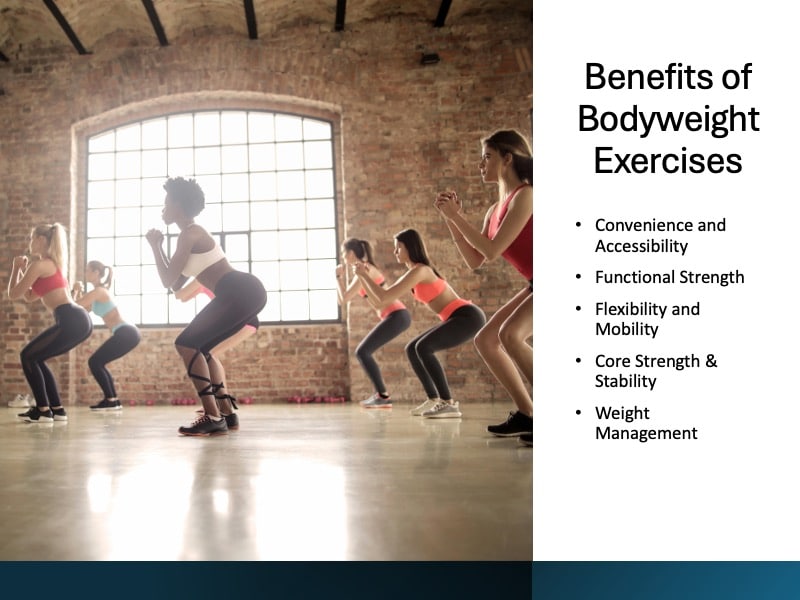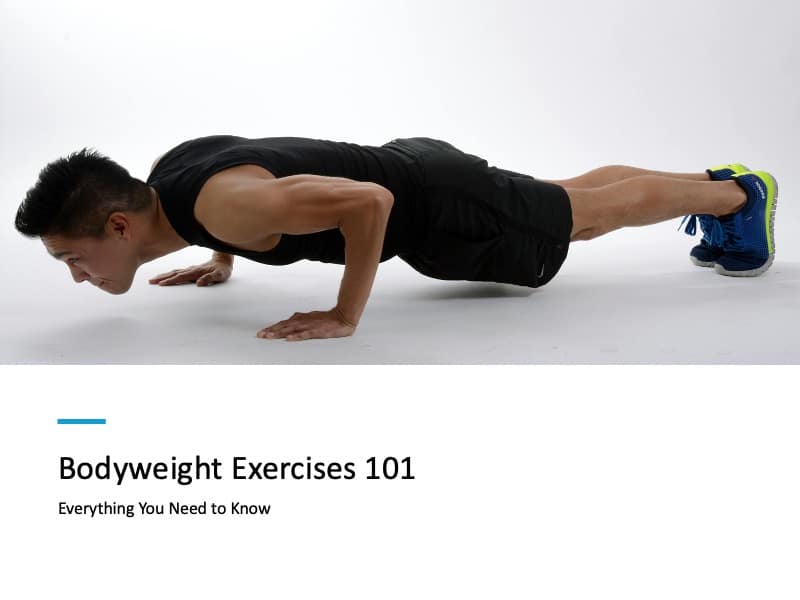Bodyweight exercises are an excellent way to improve fitness, build strength, and boost flexibility without requiring equipment. These movements offer a practical, accessible solution to staying fit, whether you’re working out from home, traveling, or simply looking for a quick routine.
The versatility of bodyweight exercises makes them suitable for all fitness levels, from beginners just starting their fitness journey to advanced athletes looking to maintain and enhance their performance.
By mastering bodyweight exercises, you’ll not only develop functional strength but also improve coordination, balance, and endurance.
Additionally, this type of exercise forms a solid foundation for future progressions and can be modified to continually challenge your body.
In this guide, you’ll learn the best bodyweight exercises for beginners, how to make progress over time, and why they should be an essential part of your training program.
What Are Bodyweight Exercises?
Bodyweight exercises are movements that utilize your own body as resistance to build strength and improve fitness.
Unlike traditional weightlifting, which requires equipment like barbells or dumbbells, bodyweight exercises leverage gravity and your body’s natural movement patterns to create resistance.
One of the greatest advantages of bodyweight training is its flexibility—you can perform these exercises anywhere, whether at home, outdoors, or even while traveling, making them a convenient option for maintaining fitness in any environment.
Benefits of Bodyweight Exercises

Bodyweight exercises offer numerous advantages that go beyond just building muscle. They are versatile, requiring no equipment, which makes them accessible and convenient for anyone, regardless of location or fitness level.
By integrating bodyweight exercises into your routine, you can improve functional strength, enhance flexibility, and develop greater overall body control.
These exercises also promote injury prevention and weight management, making them an essential component of a well-rounded fitness regimen.
Whether you’re a beginner or an advanced athlete, the benefits of bodyweight training are extensive and long-lasting.
Convenience and Accessibility
You don’t need any fancy equipment or even a gym membership to perform bodyweight exercises. They can be done virtually anywhere, making it easier to fit a workout into a busy schedule.
Functional Strength
Bodyweight exercises enhance functional strength, which means you’re training your muscles to work together efficiently.
Movements like squats, push-ups, and lunges mimic real-life activities, improving strength and coordination in day-to-day tasks.
Flexibility and Mobility
Many bodyweight exercises, like lunges and mountain climbers, challenge your flexibility and mobility while building strength.
This balance between strength and flexibility helps prevent injuries and keeps your joints healthy.
Core Strength & Stability
Almost all bodyweight exercises engage the core muscles, as they play a crucial role in stabilizing your body during dynamic movements.
A strong core is vital for overall body strength and stability, which translates into improved performance in other activities.
Weight Management
Bodyweight exercises often require the use of large muscle groups, which means they can be effective for burning calories and managing weight.
High-repetition sets or high-intensity bodyweight workouts can significantly boost your metabolism.
How to Progress with Bodyweight Training
One of the common misconceptions about bodyweight training is that it lacks scalability or progression. However, bodyweight exercises can be easily modified to become more challenging over time, ensuring continual muscle growth and improved fitness. Below are a few ways to progress:
- Increase Repetitions: Start with a manageable number of repetitions and gradually increase the volume. For example, if you begin with 10 push-ups, aim to increase that number each week.
- Tempo Training: Slow down the movement to increase the time your muscles are under tension. For example, slow squats or push-ups engage your muscles for longer, creating a greater challenge.
- Change the Angle: For exercises like push-ups or rows, modifying the angle of your body can increase the difficulty. Elevated feet push-ups, for example, make the movement more intense.
- Plyometrics: Add explosive movements, such as jump squats or plyometric push-ups, to build power and strength.
- Add Variations: Try more advanced variations of basic exercises. For instance, after mastering regular squats, progress to Bulgarian split squats, or after mastering push-ups, attempt hand-release push-ups or dive bomber push-ups.
The Best Bodyweight Exercises for Beginners
Bodyweight exercises are a fantastic starting point for beginners because they offer an accessible, equipment-free way to build strength, improve coordination, and increase endurance.
Unlike weight training, where you rely on external weights, bodyweight exercises harness the resistance of your own body, making them easier to adapt to your current fitness level. Whether your goal is to build muscle, improve flexibility, or boost overall fitness, these exercises provide a solid foundation for progress.
Incorporating these movements into your routine allows you to target multiple muscle groups, ensuring a balanced approach to strength and mobility.
The following list includes some of the best bodyweight exercises for beginners. Each exercise is chosen for its ability to help you develop full-body strength while improving functional fitness.
Whether you’re just starting out or looking for simple but effective exercises to add to your routine, these movements are essential for laying the groundwork for a stronger, fitter body.
1.) Bodyweight Squat (Air Squat)
The bodyweight squat is a fundamental movement that builds leg strength and improves lower body mobility. It primarily targets the quadriceps, hamstrings, and glutes while also engaging the core for stability.
- How to Perform: Stand with your feet shoulder-width apart, toes slightly pointed out. Lower your body by bending your knees and hips as if you’re sitting back in a chair. Go as low as your flexibility allows, aiming to get your thighs parallel to the ground. Return to standing by driving through your heels.
2.) Jump Squat
Jump squats are a plyometric variation of the air squat that helps build explosive power in the lower body.
- How to Perform: Perform a regular squat, but instead of standing back up, explode upward into a jump. Land softly with knees bent to absorb the impact, and repeat.
3.) Pull-Up & Chin-Ups
Pull-ups and chin-ups are two of the best upper-body exercises for building back strength and improving grip. They engage multiple muscle groups, including the lats, biceps, and shoulders.
- How to Perform: Grab a pull-up bar with an overhand grip, slightly wider than shoulder-width. Pull your chest towards the bar, focusing on engaging your lats, and lower yourself back down with control.
Related Reading: Inverted Rows, Pull-ups, or Chinups: Which Should You Do?
4.) Reverse Lunge
The reverse lunge is a safer alternative to the forward lunge, especially for individuals with knee pain. It works the quadriceps, glutes, and hamstrings while challenging balance.
- How to Perform: Stand tall and step one leg back into a lunge position, lowering your body until both knees form 90-degree angles. Push through your front heel to return to standing, and repeat on the other leg.
5.) Bulgarian Split Squat
The Bulgarian split squat is one of the best bodyweight exercises for building lower body strength and improving stability.
- How to Perform: Stand a few feet in front of a bench or sturdy surface. Place the top of one foot on the bench behind you and lower your body into a squat, keeping your chest upright. Return to standing and repeat.
6.) Push-Up
Push-ups are one of the most effective exercises for building upper body strength, targeting the chest, shoulders, triceps, and core.
- How to Perform: Start in a plank position with your hands slightly wider than shoulder-width apart. Lower your chest to the ground by bending your elbows, then push back up to the starting position.
7.) Jumping Jacks
Jumping jacks are a great cardio exercise that also improves coordination and endurance. They are simple but effective for increasing heart rate and burning calories.
- How to Perform: Start by standing with your feet together and arms at your sides. Jump your feet out while raising your arms overhead, and then return to the starting position.
8.) Mountain Climbers
Mountain climbers are a full-body exercise that improves cardiovascular fitness while engaging the core, shoulders, and legs.
- How to Perform: Start in a plank position. Drive one knee towards your chest, then switch legs, moving at a steady pace as if you’re running in place in a plank position.
9.) Glute Bridge
The glute bridge is an excellent bodyweight exercise for targeting the glutes and hamstrings while also improving core stability.
- How to Perform: Lie on your back with your knees bent and feet flat on the ground. Push through your heels to lift your hips towards the ceiling, squeezing your glutes at the top of the movement.
10.) Step Ups
Step-ups are a functional exercise that strengthens the quads, glutes, and calves, improving leg stability.
- How to Perform: Stand in front of a sturdy surface or bench. Step one foot onto the surface, push through your heel to stand up, then step back down and repeat on the other side.
Sample Bodyweight Workouts for Beginners
For those new to fitness or looking to add variety to their routine, bodyweight workouts provide a simple yet highly effective way to build strength and endurance. These beginner-friendly routines can be done anywhere and require no special equipment, making them perfect for fitting exercise into a busy schedule.
By targeting multiple muscle groups at once, these workouts help improve overall fitness and form a solid foundation for more advanced training.
Whether your goal is to boost cardiovascular health, tone your muscles, or simply stay active, these sample bodyweight workouts are an excellent starting point.
Beginner Bodyweight Circuit
This full-body workout will improve strength and endurance. Perform the exercises in a circuit format, moving from one to the next with minimal rest.
- 5 Rounds:
- 20 Glute Bridges
- 10 Air Squats
- 10 Push-Ups
- 10 Bulgarian Split-Squats (each leg)
- 5 Pull-Ups
- 10 Jump Squats
- 10 Inverted Rows
- 10 Reverse Lunges (each leg)
- 30 Mountain Climbers
- 20 Jumping Jacks
- 20 Step Ups
5-10-15 Workout
This is a simple workout for beginners that targets the entire body and can be done quickly.
- 5 Push-Ups
- 10 Sit-Ups
- 15 Squats
- 5 Jump Squats
- 10 Alternating Lunges
- 15 Reverse Crunches
Rest for 10 seconds, then repeat the circuit 2-3 times if you’re up for the challenge.
The Half Cindy
Inspired by a classic CrossFit workout, the Half Cindy is an excellent beginner workout that can be done in 10 minutes.
- Pull-Ups: 5 reps
- Push-Ups: 10 reps
- Squats: 15 reps
Perform as many rounds as possible within 10 minutes.
Final Thoughts: Are Bodyweight Exercises Good for You?
Bodyweight exercises are often overlooked in favor of traditional strength training with weights and machines, but their benefits are undeniable.
They help build functional strength, enhance flexibility, and offer a scalable approach to fitness, making them an excellent choice for both beginners and experienced athletes.
Incorporating bodyweight exercises into your strength training routine creates a strong foundation for overall fitness, whether your goal is weight loss, muscle building, or simply improving your health. These exercises are adaptable, and with consistent effort and progression, they can remain a valuable part of your regimen for years.
The key to long-term success with bodyweight exercises is consistency and gradual progression.
By tracking your progress, increasing repetitions, or incorporating advanced variations, you’ll continue to challenge your body and see results.
Keep evolving your workouts, and bodyweight training will help you build the strength, endurance, and flexibility needed for lifelong fitness.


Leave a Reply